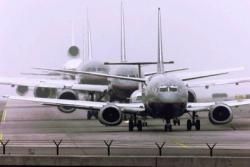Several Carriers Likely To Fail At Current Oil Prices
 Along with skyrocketing
oil prices and a slump in airline fortunes, has come a flurry of
studies forecasting imminent doom for several US carriers.
According to a study issued Thursday by AirlineForecasts, LLC and
the Business Travel Coalition, several large and small US airlines
will default on their obligations to creditors beginning at the end
of 2008 and early 2009.
Along with skyrocketing
oil prices and a slump in airline fortunes, has come a flurry of
studies forecasting imminent doom for several US carriers.
According to a study issued Thursday by AirlineForecasts, LLC and
the Business Travel Coalition, several large and small US airlines
will default on their obligations to creditors beginning at the end
of 2008 and early 2009.
The study shows that $130/barrel oil prices will increase yearly
airline costs by $30 billion, while airlines will be able to
generate only $4 billion in fare increases and incremental fees.
The implication of this alarming trend is that several large and
small airlines will ultimately end up in bankruptcy, and of those,
some will be forced to liquidate.
"If oil prices stay anywhere near $130/barrel, all major legacy
airlines will be in default on various debt covenants by the end of
2008 or early 2009," the study conducted by AirlineForecasts for
BTC states. "US commercial aviation is in full blown crisis and
heading toward a catastrophe."
"Airlines are the primary source of inter-city transportation,
critical to national and local economic development, the flow of
human capital, movement of just-in-time parts for manufacturing,
perishable food and other goods critical to our economy," the study
says. "With airlines gravely threatened, so is our economic
well-being."
Among the study's findings:
-
 The top 10 US airlines
will spend almost $25 billion in higher fuel costs this year over
last year when jet fuel averaged $2.11 per gallon. Fuel hedge
benefits could offset $5 to $6 billion of the increased fuel
costs.
The top 10 US airlines
will spend almost $25 billion in higher fuel costs this year over
last year when jet fuel averaged $2.11 per gallon. Fuel hedge
benefits could offset $5 to $6 billion of the increased fuel
costs.
- Earnings for the group, when one-time reorganization charges
are removed, were less than $4 billion in 2007, the only year of
profitability this decade. The group could lose as much as $9
billion over the next 12 months if the current range of oil prices
holds.
- Industry fares will have to increase at least 20% -- across the
board and on average -- just to cover the dramatic gap-up in fuel
costs from 2007. This is not possible given the level of uneconomic
seat capacity in the system today.
- The upshot of higher fares is less traffic, and given a
reasonable estimate of price elasticity, the industry will
eventually be forced to shrink its seat capacity by 15% to 20%.
However, there is no guarantee that a transition to a smaller, more
expensive (for the consumer) airline industry would be successful
and sustainable.
- Airlines have the ability to raise some cash, and moreover,
suppliers such as aircraft manufacturers, leasing companies and
travel management companies will have an incentive to support large
airlines that provide a stream of value. Nevertheless, without a
swift reduction in the price of fuel, the industry is headed toward
a massive failure that will result in more bankruptcies, including
liquidations.
"The US airlines, and those who depend on them, are watching
with growing alarm as their cash reserves fall precipitously toward
zero as the price of oil, already at unsustainable levels,
continuously spikes into uncharted territory," the study says.
"These airlines have never faced a darker future."

"Brand name legacy carriers that we and American communities
from coast to coast have depended upon for decades to provide us
with affordable, frequent air service are running out of cash, and
therefore, toward a date with bankruptcy and liquidation," the
report warns.
 ANN's Daily Aero-Term (05.09.24): Hold Procedure
ANN's Daily Aero-Term (05.09.24): Hold Procedure ANN's Daily Aero-Term (05.06.24): Altitude Readout
ANN's Daily Aero-Term (05.06.24): Altitude Readout ANN's Daily Aero-Linx (05.06.24)
ANN's Daily Aero-Linx (05.06.24) Airborne-NextGen 05.07.24: AI-Piloted F-16, AgEagle, 1st 2 WorldView Sats
Airborne-NextGen 05.07.24: AI-Piloted F-16, AgEagle, 1st 2 WorldView Sats Aero-News: Quote of the Day (05.07.24)
Aero-News: Quote of the Day (05.07.24)





